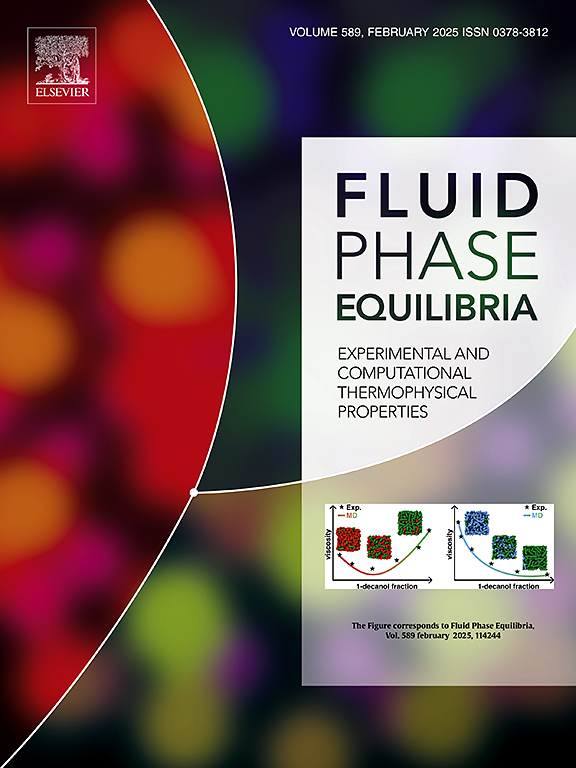Nitrous oxide capture using DL-menthol and tetrabutylammonium bromide based deep eutectic solvents
IF 2.8
3区 工程技术
Q3 CHEMISTRY, PHYSICAL
引用次数: 0
Abstract
This study investigates the viability of two deep eutectic solvents for the nitrous oxide (N2O) capture. The N2O solubility in deep eutectic solvents composed of {tetrabutylammonium bromide: decanoic acid} [1:2] and {DL-menthol: dodecanoic acid} [2:1] were measured over a temperature range from 293.15 K to 373.15 K and at pressures up to 122 bar using a high pressure variable volume cell. The experimental results show that the N2O solubility in similar in both two DES at low temperature. At temperature higher than 323 K, {DL-menthol: dodecanoic acid} is more efficient than {tetrabutylammonium bromide: decanoic acid} for N2O capture. Both solvents are slightly more effective than conventional solvents such as Triethylene glycol monomethyl ether. The PC-SAFT and COSMO-RS models were used to represent the experimental data. Average absolute deviations of 5 % for {tetrabutylammonium bromide: decanoic acid} system and 5.61 % for {DL-menthol: dodecanoic acid} system are obtained with PC-SAFT. COSMO-RS model predicts well the binary system (N2O + {tetrabutylammonium bromide: decanoic acid}) but larger deviation is observed with (N2O + {DL-menthol: dodecanoic acid}).
求助全文
约1分钟内获得全文
求助全文
来源期刊

Fluid Phase Equilibria
工程技术-工程:化工
CiteScore
5.30
自引率
15.40%
发文量
223
审稿时长
53 days
期刊介绍:
Fluid Phase Equilibria publishes high-quality papers dealing with experimental, theoretical, and applied research related to equilibrium and transport properties of fluids, solids, and interfaces. Subjects of interest include physical/phase and chemical equilibria; equilibrium and nonequilibrium thermophysical properties; fundamental thermodynamic relations; and stability. The systems central to the journal include pure substances and mixtures of organic and inorganic materials, including polymers, biochemicals, and surfactants with sufficient characterization of composition and purity for the results to be reproduced. Alloys are of interest only when thermodynamic studies are included, purely material studies will not be considered. In all cases, authors are expected to provide physical or chemical interpretations of the results.
Experimental research can include measurements under all conditions of temperature, pressure, and composition, including critical and supercritical. Measurements are to be associated with systems and conditions of fundamental or applied interest, and may not be only a collection of routine data, such as physical property or solubility measurements at limited pressures and temperatures close to ambient, or surfactant studies focussed strictly on micellisation or micelle structure. Papers reporting common data must be accompanied by new physical insights and/or contemporary or new theory or techniques.
 求助内容:
求助内容: 应助结果提醒方式:
应助结果提醒方式:


